
Have you ever had a fish break your line right when you thought you were about to reel it in?
Yeah, it’s a common frustration. It happens to all of us, and often, it’s because our fishing line is past its prime.
But how long does the fishing line really last? The answer isn’t so simple – it depends on a bunch of things, like whether it’s monofilament line, fluorocarbon line, or braided line, and how you take care of it.
The sun’s UV rays, how often you fish, and even how you store your line all play a part. Let’s dive into it.
Remember, when in doubt, change your line! It’s better to be safe than sorry and lose that big catch.
How Long Does Fishing Line Last
- Different types of fishing line have different lifespans:
- Monofilament: 1-2 years with regular use.
- Fluorocarbon: 1-2 years with regular use, potentially longer than mono.
- Braided: Several years, the most durable.
- Factors affecting lifespan:
- Sun and UV light exposure (the biggest enemy).
- How often and hard you fish.
- Type of water (salt water is tougher).
- How you take care of your line.
- Signs it’s time to replace your line:
- Visible nicks, frays, or discoloration.
- Stiffness, brittleness, or excessive tangles.
- Breaking off fish or slipping knots.
- Storage tips:
- Keep the line in a cool, dark, dry place.
- Use spools or reels to prevent tangling.
Fishing Line Types and Their Lifespans
Not all fishing lines are created equal. There are three main types you’ll find at the store: monofilament fishing line, fluorocarbon fishing line, and braided fishing line. Each has its perks and quirks, and how long they last can be pretty different.

Monofilament Line
This is the most common type you’ll see, also called “mono line.”
It’s like the all-around player on a sports team – good at a lot of things but not the best at any one thing. Mono is cheap, easy to use, and comes in a bunch of different strengths (called “line test”).
But it doesn’t do so well with sunlight (those UV rays weaken it over time), and it can get nicked or cut up more easily than other lines. If you take care of it, it can last a few years on the shelf (mono shelf life), but if you fish a lot, you might want to change it out every year or so.
Fluorocarbon Line
This line is like Mono’s stealthy cousin. It’s harder to see underwater, making it a good choice when fish are being picky. It also resists nicks and cuts better than monofilament lines.
But fluorocarbon lines are a bit stiffer and can be trickier to tie knots with. As for how long it lasts, it’s similar to mono: a few years on the shelf if stored right, and maybe a year or two of regular fishing.
Braided Lines
This is the powerhouse of fishing lines. It’s super strong for its size, meaning you can use a thinner line that’s easier to cast and still catch big fish. It also lasts the longest out of all the lines, sometimes up to 5 years or more.
But it’s more expensive and not the best choice for every situation, especially if you need a line that stretches a bit.
Extra tips:
So, how long your fishing line lasts really depends on what kind you’re using. There’s no magic number, but knowing the average shelf life and how each line holds up will help you choose the right one for your next fishing trip.
Factors That Impacting Fishing Line Longevity

- UV Light:
- The sun’s UV light weakens fishing lines over time, especially the monofilament line.
- If you fish often in sunny spots, your line won’t last as long, even if you bought bulk spools of fishing line.
- Type of Fishing:
- Heavy casting and reeling in big fish wear down the line faster.
- Fishing in rocky areas or around underwater obstacles can scrape and damage lines.
- Line Care:
- Rinse your fishing line with fresh water after each trip to remove salt, dirt, and other debris.
- Store your line properly in a cool, dark place like a tackle box or drawer.
- Avoid leaving lines out in the sun or extreme temperatures.
- Line Damage:
- Check your line for nicks, cuts, or weak spots.
- Even small damage can cause your line to break when you hook a fish.
- Many anglers and various fishing publications recommend changing your line if you’re unsure about its condition.
Remember: How long your fishing line lasts depends on multiple factors, including the type of line, how you use it, and how you care for it. By following these tips, you can keep your line in good shape and enjoy those tight lines!
Signs Your Fishing Line Needs Replacing

- Visual Cues:
- Nicks, cuts, or frayed spots
- Faded or discolored line (especially from UV light exposure)
- Feel of the Line:
- Stiff or brittle texture
- Increased tangles and knots
- Performance Issues:
- Breaking off more fish than usual
- Knots slipping easily
- General Guidelines:
- Monofilament line: Change annually or more often with heavy use.
- Fluorocarbon line: Change every 1-2 years or more often with heavy use.
- Braided line: Change every few years, but still check regularly.
Tip: When in doubt, ask for advice at your local tackle shop. It’s better to be safe and use an extra line than to risk losing a fish due to a worn-out line.
Proper Storage of Fishing Line
Okay, so we’ve talked about how to spot when your fishing line is worn out, but how can you keep it in good shape for as long as possible? It all comes down to how you store it. Think of it like putting your bike in the garage instead of leaving it out in the weather.

First things first, keep your fishing line away from the sun and heat.
Those UV rays we talked about earlier can really mess up your line, especially monofilament and fluorocarbon lines. Heat can also cause the line to become brittle and weak. So, you can find a cool, dry place to store your fishing gear, like a closet or basement.
If you’ve got a bunch of lines on a big spool, don’t just leave it lying around. Could you wind it onto a smaller spool or reel? This keeps it organized and helps prevent tangles.
If you leave it in a continuous strand, it can get twisted or knotted, making it harder to use. Plus, it’s easier to grab a smaller spool when you need some new line for your reel.
Different types of fishing lines have different storage needs. Monofilament and fluorocarbon are made from nylon, which can stretch over time if not stored properly. A braided line is made from fibers that don’t stretch as much, but it can still get damaged if left out in the elements. So, no matter what type of line you use, taking care of it will help it last longer.
Now, here’s the million-dollar question: How long can you store fishing lines?
Well, there’s yet to be an official answer, but most folks say monofilament and fluorocarbon can last two to three years if stored properly. Braids can last even longer, maybe several years.
But remember, even if your line looks fine after being stored for a very long time, it’s always a good idea to check it before you head out fishing. Give it a good stretch and see if it feels weak or brittle. If you have any doubts, it’s better to replace it.
After all, you don’t want to lose that nice fish because your old line couldn’t handle it!
When to Change Your Fishing Line

- General Rule of Thumb:
- Monofilament and fluorocarbon lines: Change every 1-2 years.
- Braided line: Change every few years.
- Factors to Consider:
- Frequency of use: If you fish often, change your line more frequently.
- Type of fish you catch: Bigger fish put more stress on your line, so you might need to change it sooner.
- Line condition: Always check for signs of wear and tear before heading out.
- Gut Feeling:
- If you’re not sure whether to change your line, it’s always better to err on the side of caution and put on a new line.
Remember: Changing your fishing line regularly can help you avoid losing that big catch!
Conclusion
Alright, so there you have it! We’ve covered a lot of ground when it comes to how long the fishing line lasts.

You’ve learned about the different types of lines (mono, fluoro, and braid) and how their lifespans compare. You’ve also learned about the things that can wear down your line faster, like sunlight and constant use.
Remember, there’s no magic number for how long your fishing line will last.
It depends on the type of line, how you use it, and how well you take care of it. But by paying attention to your line, checking it for wear and tear, and storing it properly, you can make sure it lasts as long as possible.
And remember, don’t be afraid to change your line if you’re unsure about its strength. It’s a small price to pay for peace of mind and a better chance of landing that big fish you’ve been dreaming of.
So, next time you’re out on the water, take a moment to think about your fishing line. It might just be the difference between a good day of fishing and a frustrating one. Now get out there and catch some fish!
Frequently Asked Questions
Does the type of fishing line affect how long it lasts?
Absolutely! Different fishing lines have different lifespans. Braided lines are the most durable, followed by fluorocarbon and monofilament. Mono is the most susceptible to UV damage and abrasion.
How often should I change my fishing line?
There’s no one-size-fits-all answer. It depends on the type of fishing line, how often you fish, and how hard you are on your gear. As a general rule, change monofilament and fluorocarbon lines every 1-2 years and braided lines every few years.
Can I tell if my fishing line is bad just by looking at it?
Yes! Look for nicks, fraying, or discoloration. If your line feels stiff or brittle, it’s time for a change. Also, if you’re breaking off fish or your knots keep slipping, your line is likely weakened.
Does how I store my fishing line matter?
Definitely! Storing your line properly can help extend its life. Please keep it in a cool, dark, dry place, away from direct sunlight and heat. Avoid leaving it in a continuous strand to prevent tangles.
Can I use the old fishing line if it still looks okay?
It’s not recommended. Even if it looks fine, the line can lose breaking strength over time due to UV exposure and general wear and tear. If you’re unsure, it’s always better to replace it.










